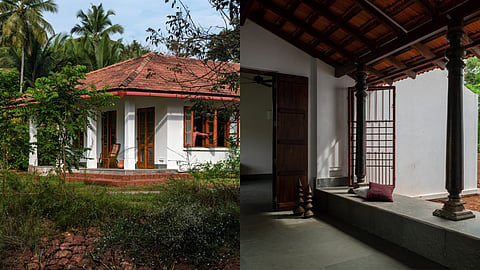
- HOMEGROWN WORLD
- #HGCREATORS
- #HGEXPLORE
- #HGVOICES
- #HGSHOP
- CAREERS
- ABOUT US
- CONTACT US

A huge part of Goa's visual identity comes from its architecture. The tropical paradise is enriched with a hybrid of Mediterranean and Indian architectural elements suited to the climate of the region. a mix of neo-classic and neo-gothic styles, most Goan houses between 18-20th century and unlike the misconception aren't exactly Portuguese architecture. Although they had elements from it, a Goan house got its character from using local crafts, skills and materials and gave birth to Indo-Portuguese architecture.
Balcaos, verandahs and columns are how a typical 'Goan' house is identified. Laterite blocks, wooden beama and Mangalorean tiles give them their distinct look and protect the house from hot summers and monsoon. Borrowing from Portuguese architecture, a Goan house is inward-facing with courtyards in the centre. Specific rooms allocated for different purposes like a library, card rooms, dining rooms etc. is also a characteristic of a Goan house. With time, the maintenance of Goan villas got unsustainable which is also the reason these days the newer houses that are being in the state are comparatively modern. But one architecture studio is trying their best to keep the spirit of old Goa alive through its luxury villas that are contemporary in design but Goan in spirit.
Grounded is a studio whose design aesthetics tie 'rustic-vernacular and contemporary style in perfect balance'. Founded by principal architect Anjali Mangalgiri, the studio believes in building houses rooted in sound architectural principles that reconnect its inhabitants to nature and simple joys of life. They note on their website, "Fresh air, natural light, fertile soil, love and laughter: the essentials of well-being that are too often lost in the chaos of modern living."
What makes them stand out however, is the use of design that ruled the Indo-Portuguese architecture in Goa in a contemporary and understated way. Take the Balcao for example, the outdoor porch that is considered a key element in identifying a Goan house. When Balcaos were first added to the architecture in Goa, they started acting as social devices, opening up the houses to the outside that once were inward-facing. These spaces became a middle ground between the inside and the outside and were used as a reception area for the guests before they came in.
In the luxury villas by Grounded you can see the influence of the Goan Balcao not just in the front porch but all around the house. Navovado, a vacation house in Pomburpa village designed by the studio even has a seating that is reminiscent of the Balcaos where elders would sit and gossip, drink tea or greet their neighbours as they passed in an old Goa. A large central courtyard in the vacation house takes its inspiration from the Konkani 'raj-angan' that ventilated Goan houses.
The house with three pavillions, another project by them studio located in Mandrem, is morphed into its surrounding landscapes with extensive verandahs, courtyards and open spaces. The central seasonal pond and the local red terracotta tiles on their roofs is another nod to the materials that made Goan houses essentially Indo-Portuguese.
Grounded's artistry lies in its ability to recreate old Goa through a new one. Their luxury villas are extremely modern and opulent reflecting the times they come from and yet, there's a certain familiarity within the spaces that exude the charm of an old-school Goan villas. It's quiet but makes itself felt through the design. Hitting the mark on their ethos, the studio builds houses than both stand out in their opulence and blend in with resonance, in Goa's architectural landscape.
Follow Grounded here.
